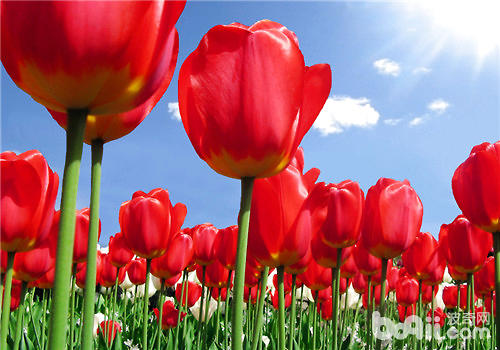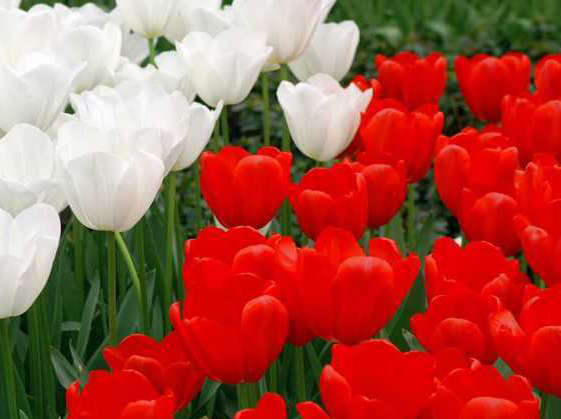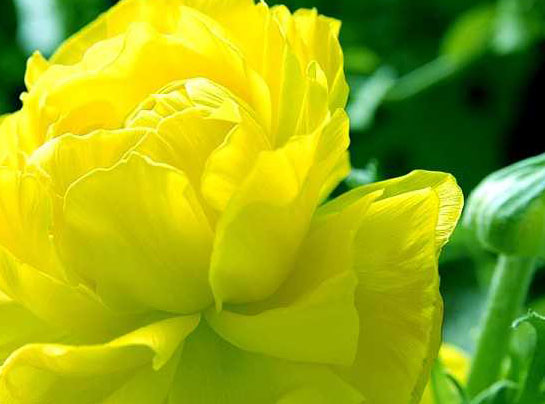What are the growth characteristics and ecological habits of tulips?
Tulips adapt to cold and humid winters and dry and hot summers. Dormant in summer, rooting and sprouting in autumn and winter, but not unearthed. It is necessary to stretch and grow to form stems and leaves around the first ten days of February (the temperature is above 5 degrees Celsius) after low temperature in winter, and bloom from March to April. The suitable temperature for growth and flowering is 15-20 degrees Celsius. Flower bud differentiation takes place during summer storage when the bulbs are dug out of the basin when the stems and leaves turn yellow. The suitable temperature for differentiation is 20-25 degrees Celsius, and the highest temperature shall not exceed 28 degrees Celsius.
Tulip is a long sunny flower with plenty of sunshine, warm and humid winter and cool and dry climate in summer. Cold tolerance is very strong, if there is thick snow cover in cold areas, the bulb can survive the winter in the open field. But afraid of the heat, if the summer comes early, the summer is very hot, then the bulb is difficult to spend the summer after dormancy. Loose, fertile, well-drained slightly acidic sandy loam is required. Avoid alkaline soil and continuous cropping.

Tulips (details)
Tulips are native to the mountains of Iran and Turkey. Due to the climate of the Mediterranean, tulips adapt to cold and humid winter and dry and hot summer, and have the characteristics of dormancy in summer, rooting and sprouting in autumn and winter, but not unearthed. After low temperature in winter, around the first ten days of February (the temperature is above 5 ℃), tulips begin to stretch and grow to form stems and leaves, and blossom from March to April.
The optimum temperature for tulip growth and flowering is 15-20 ℃. Flower bud differentiation is carried out during summer storage when the bulbs are dug up from the basin when the stems and leaves turn yellow. The optimum temperature for differentiation was 20-25 ℃, and the highest was not more than 28 ℃.
Tulip is a long sunny flower with plenty of sunshine, warm and humid winter and cool and dry climate in summer. Cold tolerance is very strong, in cold areas, if there is thick snow cover, the bulb can overwinter in the open field, but afraid of hot heat, if the summer comes early, the midsummer is very hot, the bulb is difficult to spend summer after dormancy. Tulips require loose, fertile, slightly acidic sandy loam with good drainage, alkali soil and continuous cropping.
An introduction to the pictures and growth characteristics of black tulips
Tulip, everyone is very familiar with, belongs to the Liliaceae herb, is the national flower of Turkey, Kazakhstan and the Netherlands, although its hometown is in a foreign country, but with the progress of the times, tulips have become common flowers in daily life with the progress of the times. many editors can't help but ask when they see the question, are tulips black? What are its habits and living environment? Today, the editor will take you to appreciate the black tulips! By the way, let's talk about it!
Black tulip is one of the flower colors of Liliaceae. In early February 2005, it was cultivated by three students of Singapore Institute of Technology, commonly known as "Night Queen", which is one of the rare tulips in the market. Black tulips were cultivated by graduates of the Biotechnology Department of Singapore Institute of Technology using pure nutrient solution. They began to cultivate these tulips in August 2004. In early February 2005, black tulip varieties were successfully obtained.
Due to the climate of the Mediterranean, tulips adapt to cold and humid winter and dry and hot summer, which are characterized by dormancy in summer, rooting and sprouting in autumn and winter, but not unearthed. They need to stretch and grow to form stems and leaves in the first ten days of February (temperature above 5 ℃) after low temperature in winter, and bloom from March to April. The suitable temperature for growth and flowering is 15-20 ℃. Flower bud differentiation is carried out during summer storage when the bulbs are dug up from the basin when the stems and leaves turn yellow. The optimum temperature for differentiation was 20-25 ℃, and the highest was not more than 28 ℃. Long-day flowers, sexual preference to the sun, shelter from the wind, warm and humid in winter, cool and dry climate in summer. It can grow normally above 8 ℃ and can generally withstand the low temperature of-14 ℃.
Cold tolerance is very strong, in cold areas, if there is thick snow cover, the bulb can overwinter in the open field, but afraid of hot heat, if the summer comes early, the midsummer is very hot, the bulb is difficult to spend summer after dormancy. The slightly acidic sandy loam with rich humus, loose and fertile soil and good drainage is required. Avoid alkaline soil and continuous cropping.
The word enchanting and magnificent is perfect for black tulips. Its beauty is not the same as the delicate beauty of roses, but belongs to the poisonous beauty of poppy flowers, and there is the gentleman air of lotus flowers that comes out of the mud and makes you intoxicated at a glance. It represents the spirit of chivalry and melancholy love. When you see it, it seems to think of the beauty who stole your heart. All right. The above is the editor's full introduction to the black tulips. I hope such a beautiful picture can bring you visual enjoyment.
- Prev

How to make potted tulips blossom in New Year's Day and Spring Festival
Tulips are cultivated by promoting cultivation. Put the bulb in a cool outdoor place after planting, keep the pot soil dry and not wet until 1-2 months before the planned flowering period, then move the flowerpot to 5: 10 degrees Celsius, and then move to 15: 18 degrees Celsius temperature and sunshine after leaf emergence to increase water and fertilizer.
- Next

How to maintain buttercup
The flower hair is named Persian buttercup. The flower is solitary at the top of the branch or produces a long pedicel from the axils of the leaves. Corolla rounded. There are white, yellow, orange, red, purple, brown and other colors. The florescence is from April to May. It is more hardy, but not resistant to heat, and goes dormant in summer in most parts of China. Afraid of strong light exposure, grow well in sparse shade
Related
- Fuxing push coffee new agricultural production and marketing class: lack of small-scale processing plants
- Jujube rice field leisure farm deep ploughing Yilan for five years to create a space for organic food and play
- Nongyu Farm-A trial of organic papaya for brave women with advanced technology
- Four points for attention in the prevention and control of diseases and insect pests of edible fungi
- How to add nutrient solution to Edible Fungi
- Is there any good way to control edible fungus mites?
- Open Inoculation Technology of Edible Fungi
- Is there any clever way to use fertilizer for edible fungus in winter?
- What agents are used to kill the pathogens of edible fungi in the mushroom shed?
- Rapid drying of Edible Fungi

